technical data SKODA FABIA 2008 2.G / 5J Owner's Manual
[x] Cancel search | Manufacturer: SKODA, Model Year: 2008, Model line: FABIA, Model: SKODA FABIA 2008 2.G / 5JPages: 252, PDF Size: 40.88 MB
Page 202 of 252
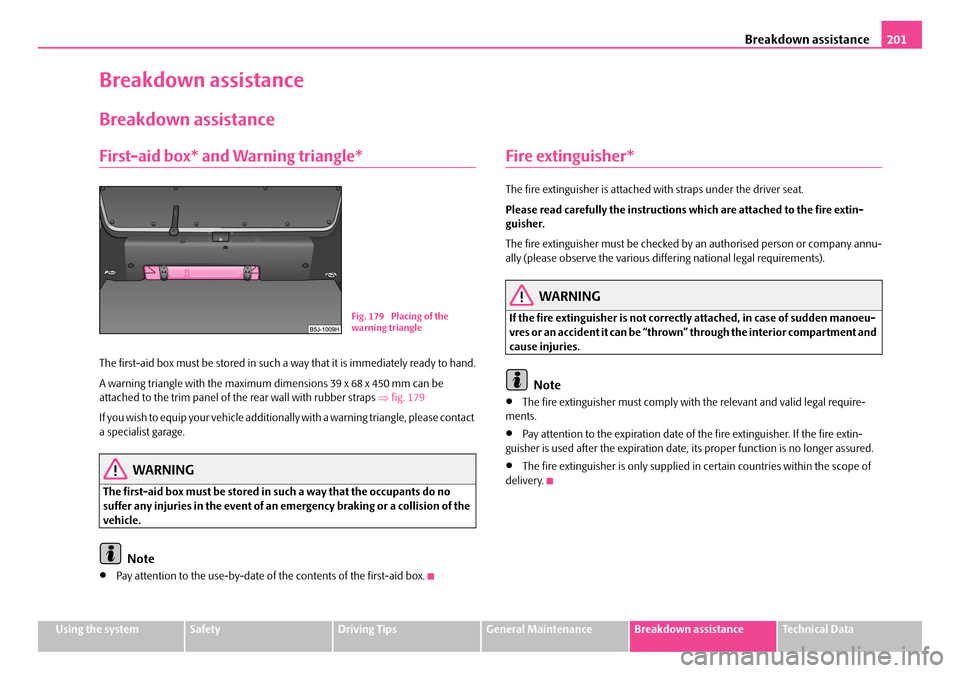
Breakdown assistance201
Using the systemSafetyDriving TipsGeneral MaintenanceBreakdown assistanceTechnical Data
Breakdown assistance
Breakdown assistance
First-aid box* and Warning triangle*
The first-aid box must be stored in such a way that it is immediately ready to hand.
A warning triangle with the maximum dimensions 39 x 68 x 450 mm can be attached to the trim panel of the rear wall with rubber straps ŌćÆfig. 179
If you wish to equip your vehicle additionally with a warning triangle, please contact a specialist garage.
WARNING
The first-aid box must be stored in such a way that the occupants do no suffer any injuries in the event of an emergency braking or a collision of the vehicle.
Note
ŌĆóPay attention to the use-by-date of the contents of the first-aid box.
Fire extinguisher*
The fire extinguisher is attached with straps under the driver seat.
Please read carefully the instructions which are attached to the fire extin-guisher.
The fire extinguisher must be checked by an authorised person or company annu-ally (please observe the various differing national legal requirements).
WARNING
If the fire extinguisher is not correctly attached, in case of sudden manoeu-vres or an accident it can be ŌĆ£thrownŌĆØ through the interior compartment and cause injuries.
Note
ŌĆóThe fire extinguisher must comply with the relevant and valid legal require-ments.
ŌĆóPay attention to the expiration date of the fire extinguisher. If the fire extin-guisher is used after the expiration date, its proper function is no longer assured.
ŌĆóThe fire extinguisher is only supplied in certain countries within the scope of delivery.
Fig. 179 Placing of the warning triangle
NKO A05F 20.book Page 201 Wednesday, April 2, 2008 1:02 PM
Page 204 of 252
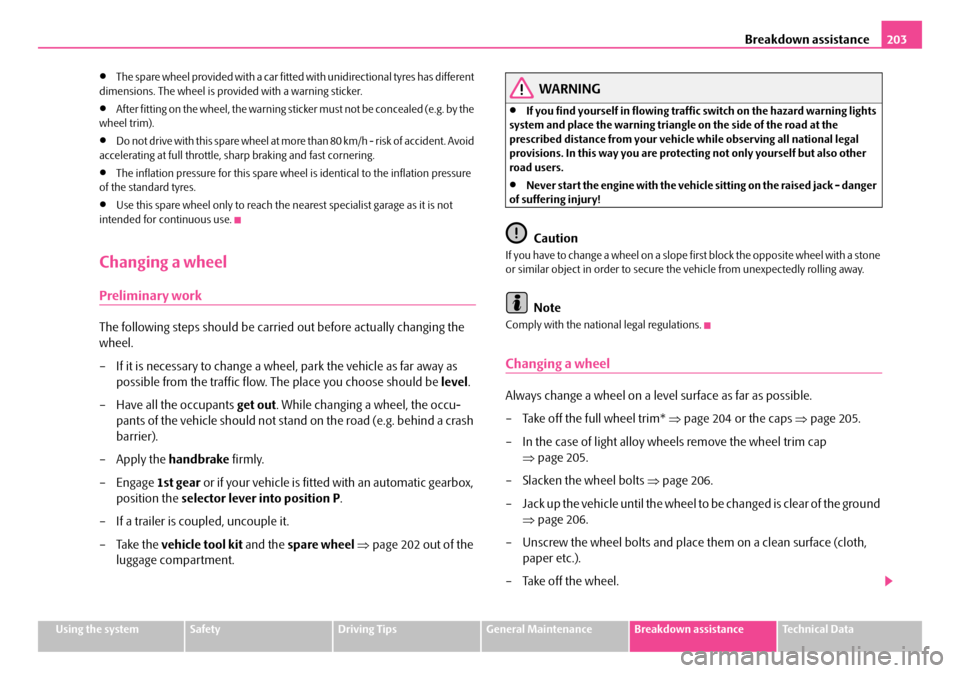
Breakdown assistance203
Using the systemSafetyDriving TipsGeneral MaintenanceBreakdown assistanceTechnical Data
ŌĆóThe spare wheel provided with a car fitted with unidirectional tyres has different dimensions. The wheel is provided with a warning sticker.
ŌĆóAfter fitting on the wheel, the warning sticker must not be concealed (e.g. by the wheel trim).
ŌĆóDo not drive with this spare wheel at more than 80 km/h - risk of accident. Avoid accelerating at full throttle, sharp braking and fast cornering.
ŌĆóThe inflation pressure for this spare wheel is identical to the inflation pressure of the standard tyres.
ŌĆóUse this spare wheel only to reach the nearest specialist garage as it is not intended for continuous use.
Changing a wheel
Preliminary work
The following steps should be carried out before actually changing the
wheel.
ŌĆō If it is necessary to change a wheel, park the vehicle as far away as
possible from the traffic flow. The place you choose should be level.
ŌĆō Have all the occupants get out. While changing a wheel, the occu-
pants of the vehicle should not stand on the road (e.g. behind a crash
barrier).
ŌĆō Apply the handbrake firmly.
ŌĆōEngage 1st gear or if your vehicle is fitted with an automatic gearbox,
position the selector lever into position P.
ŌĆō If a trailer is coupled, uncouple it.
ŌĆō Take the vehicle tool kit and the spare wheel ŌćÆpage 202 out of the
luggage compartment.
WARNING
ŌĆóIf you find yourself in flowing traffic switch on the hazard warning lights system and place the warning triangle on the side of the road at the prescribed distance from your vehicle while observing all national legal provisions. In this way you are protecting not only yourself but also other road users.
ŌĆóNever start the engine with the vehicle sitting on the raised jack - danger of suffering injury!
Caution
If you have to change a wheel on a slope first block the opposite wheel with a stone or similar object in order to secure the vehicle from unexpectedly rolling away.
Note
Comply with the national legal regulations.
Changing a wheel
Always change a wheel on a level surface as far as possible.
ŌĆō Take off the full wheel trim* ŌćÆpage 204 or the caps ŌćÆpage 205.
ŌĆō In the case of light alloy wheels remove the wheel trim cap
ŌćÆpage 205.
ŌĆō Slacken the wheel bolts ŌćÆpage 206.
ŌĆō Jack up the vehicle until the wheel to be changed is clear of the ground
ŌćÆpage 206.
ŌĆō Unscrew the wheel bolts and place them on a clean surface (cloth,
paper etc.).
ŌĆō Take off the wheel.
NKO A05F 20.book Page 203 Wednesday, April 2, 2008 1:02 PM
Page 206 of 252

Breakdown assistance205
Using the systemSafetyDriving TipsGeneral MaintenanceBreakdown assistanceTechnical Data
Caution
ŌĆóUse the pressure of your hand, do not knock on the full wheel trim! Heavy knocks mainly on the points where the full wheel trim has not been inserted into the wheel, can result in damage to the guide and centering elements of the full wheel trim.
ŌĆóFirst check for yourself that the theft-deterrent wheel bolt is located ŌćÆpage 207, ŌĆ£Securing wheels against being stolen*ŌĆØ in the hole in the area of the valve before fitting the full wheel trim onto a steel wheel which is attached with a theft-deterrent wheel bolt.
Wheel trim caps*
Pulling off
ŌĆōCarefully ŌćÆfig. 183 lever off the wheel trim cap using the removal
hook .
Wheel bolts with caps*
The caps are designed to protect the wheel bolts.
Pulling off
ŌĆō Insert the plastic clip (in the car tool kit) sufficiently far onto the cap
until the inner catches of the clip are positioned at the collar of the
cap.
ŌĆō Pull the cap off with the plastic clip ŌćÆfig. 184.
Installing
ŌĆō Insert the caps onto the bolts.
Fig. 183 Pulling off the wheel trim cap
Fig. 184 Changing a wheel: Pull off cap from the wheel bolt
NKO A05F 20.book Page 205 Wednesday, April 2, 2008 1:02 PM
Page 208 of 252

Breakdown assistance207
Using the systemSafetyDriving TipsGeneral MaintenanceBreakdown assistanceTechnical Data
surface or use a wide and stable base. Use a non-slip base (e.g. a rubber foot mat) if the surface is smooth, such as cobbled stones, a tiled floor, etc.
WARNING
ŌĆóAlways raise the vehicle with the doors closed - risk of injury.
ŌĆóTake suitable measures to prevent the base of the lifting jack from slip-ping off - risk of injury!
ŌĆóPlace the lifting jack only on a solid and even surface.
ŌĆóNot positioning the lifting jack at the specified points can result in damage to the vehicle. The jack can also slip off if it does not have sufficient grip - risk of injury!
ŌĆóNever start the engine if the vehicle is lifted - risk of accident.
ŌĆóNever lie under the vehicle if the vehicle is only lifted with the vehicle lifting jack.
ŌĆóIt is important to support the vehicle with suitable supporting blocks if you wish to work under the lifted vehicle - risk of injury!
Securing wheels against being stolen*
You need a special adapter for slackening the safety wheel bolts.
ŌĆō Pull off the full wheel trim/cap from the wheel hub or cap from the
safety wheel bolt.
ŌĆō Insert the adapter with its toothed side fully into the inner toothing
of the safety wheel bolt right down in such a way that only the
outer hexagon is jutting out ŌćÆfig. 187.
ŌĆō Insert the wheel wrench fully onto the adapter .
ŌĆō Slacken the wheel bolt, or tighten it firmly ŌćÆpage 206.
ŌĆō Reinstall the full wheel trim/wheel cap after removing the adapter or
place the cap onto the safety wheel bolt.
ŌĆō Have the tightening torque checked with a torque wrench as soon as
possible. Steel and light alloy wheels must be tightened to a tightening
torque of 120 Nm.
The safety wheel bolts on vehicles fitted with them (one safety wheel bolt per wheel) can only be loosened or tighten up by using the adapter provided.
It is meaningful to note the code number hammered into the rear side of the adapter or the rear side of the safety wheel bolts. You can obtain a replacement adapter from a ┼Ākoda Service Partner, if necessary, by quoting this number.
We recommend that you always carry the adapter for the wheel bolts with you in the vehicle. It should be stowed in the vehicle tool kit.
Caution
ŌĆóDamage can occur to the adapter and safety wheel bolt if the safety wheel bolt is tightened up too much.
ŌĆóOn steel wheels, the theft-deterrent wheel bolt must always be installed in the hole, which is close to the valve. Otherwise the full wheel trim cannot be mounted and the full wheel trim can be damaged during the assembly.
Note
The set of safety wheel bolts can be obtained from a ┼Ākoda Service Partner.
Fig. 187 Safety wheel bolt with adapter
AB
AA
AB
NKO A05F 20.book Page 207 Wednesday, April 2, 2008 1:02 PM
Page 210 of 252
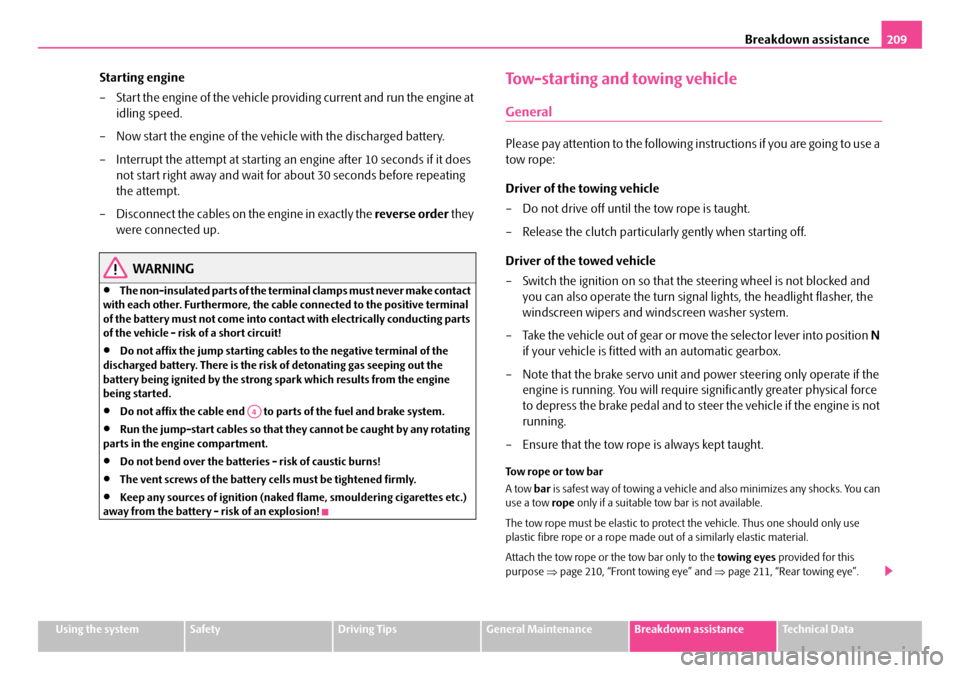
Breakdown assistance209
Using the systemSafetyDriving TipsGeneral MaintenanceBreakdown assistanceTechnical Data
Starting engine
ŌĆō Start the engine of the vehicle providing current and run the engine at
idling speed.
ŌĆō Now start the engine of the vehicle with the discharged battery.
ŌĆō Interrupt the attempt at starting an engine after 10 seconds if it does
not start right away and wait for about 30 seconds before repeating
the attempt.
ŌĆō Disconnect the cables on the engine in exactly the reverse order they
were connected up.
WARNING
ŌĆóThe non-insulated parts of the terminal clamps must never make contact with each other. Furthermore, the cable connected to the positive terminal of the battery must not come into contact with electrically conducting parts of the vehicle - risk of a short circuit!
ŌĆóDo not affix the jump starting cables to the negative terminal of the discharged battery. There is the risk of detonating gas seeping out the battery being ignited by the strong spark which results from the engine being started.
ŌĆóDo not affix the cable end to parts of the fuel and brake system.
ŌĆóRun the jump-start cables so that they cannot be caught by any rotating parts in the engine compartment.
ŌĆóDo not bend over the batteries - risk of caustic burns!
ŌĆóThe vent screws of the battery cells must be tightened firmly.
ŌĆóKeep any sources of ignition (naked flame, smouldering cigarettes etc.) away from the battery - risk of an explosion!
Tow-starting and towing vehicle
General
Please pay attention to the following instructions if you are going to use a
tow rope:
Driver of the towing vehicle
ŌĆō Do not drive off until the tow rope is taught.
ŌĆō Release the clutch particularly gently when starting off.
Driver of the towed vehicle
ŌĆō Switch the ignition on so that the steering wheel is not blocked and
you can also operate the turn signal lights, the headlight flasher, the
windscreen wipers and windscreen washer system.
ŌĆō Take the vehicle out of gear or move the selector lever into position N
if your vehicle is fitted with an automatic gearbox.
ŌĆō Note that the brake servo unit and power steering only operate if the
engine is running. You will require significantly greater physical force
to depress the brake pedal and to steer the vehicle if the engine is not
running.
ŌĆō Ensure that the tow rope is always kept taught.
Tow rope or tow bar
A tow bar is safest way of towing a vehicle and also minimizes any shocks. You can use a tow rope only if a suitable tow bar is not available.
The tow rope must be elastic to protect the vehicle. Thus one should only use plastic fibre rope or a rope made out of a similarly elastic material.
Attach the tow rope or the tow bar only to the towing eyes provided for this purpose ŌćÆpage 210, ŌĆ£Front towing eyeŌĆØ and ŌćÆpage 211, ŌĆ£Rear towing eyeŌĆØ.
A4
NKO A05F 20.book Page 209 Wednesday, April 2, 2008 1:02 PM
Page 212 of 252

Breakdown assistance211
Using the systemSafetyDriving TipsGeneral MaintenanceBreakdown assistanceTechnical Data
Rear towing eye
The rear towing eye is located below the rear bumper on the right ŌćÆfig. 191.
Tow-starting a vehicle
If the engine does not start, we generally do not recommend to tow-start
your vehicle. One should attempt to start the engine using jump start
cables ŌćÆpage 208 or call on the services of the SERVICE mobile.
If your vehicle has to be towed:
ŌĆō Engage 2nd or 3rd gear with the vehicle stationary.
ŌĆō Depress the clutch pedal fully and keep it depressed.
ŌĆō Switch on the ignition.
ŌĆō Wait until both vehicles are moving then release the clutch pedal
slowly.
ŌĆō Depress the clutch pedal fully when the engine fires and take the
vehicle out of gear.
WARNING
There is high risk of having an accident when tow-starting a vehicle, when for example the towed vehicle runs into the towing vehicle.
Caution
Vehicles which are fitted with a catalytic converter should not be tow-started over a distance of more than 50 metres. Unburnt fuel may get into the catalytic converter and damage it.
Towing in a vehicle fitted with a manual gearbox
Please refer to the notes ŌćÆpage 209.
The car can be towed in with a tow bar or a tow rope or with the front or rear wheels raised. The maximum towing speed is 50 km/h.
Towing of a vehicle with an automatic gearbox
Please refer to the notes ŌćÆpage 209.
The car can be towed in with a tow bar or a tow rope. Refer at the same time to the following guidelines:
ŌĆóMove selector lever into N.
ŌĆóThe maximum towing speed is 50 km/h.
ŌĆóThe maximum permissible towing distance is 50 km. The gear oil pump does not operate when the engine is not running; the gearbox would not be adequately lubricated at higher speeds and over longer towing distance.
Caution
If the vehicle is towed in by a recovery vehicle, it should only be towed in with the front wheels raised. If the vehicle is raised at rear, the automatic gearbox is damaged!
Fig. 191 Rear towing eye
NKO A05F 20.book Page 211 Wednesday, April 2, 2008 1:02 PM
Page 214 of 252

Fuses and light bulbs213
Using the systemSafetyDriving TipsGeneral MaintenanceBreakdown assistanceTechnical Data
Fuses and light bulbs
Electric fuses
Replacing fuses in the dash panel
Defect fuses must be replaced.
Individual electrical circuits are protected by fuses. The fuses are located
on the left side of the dash panel behind the safety cover.
ŌĆō Switch the ignition off and also the electrical component affected.
ŌĆō Carefully swivel the cover in the direction of arrow and pull it out
ŌćÆfig. 192.
ŌĆō Find out which fuse belongs to the component which is not operating
ŌćÆpage 214, ŌĆ£Fuse assignment in the dash panelŌĆØ.
ŌĆō Take the plastic clip out of its fixture in the fuse cover, insert it onto the
respective fuse and pull out this fuse.
ŌĆō Defect fuses can be detected by their melted metal strips. Replace the
defect fuse by a new fuse of the same ampere number.
ŌĆō Insert the fuse cover into the dash panel in such a way that the guide
lugs are guided into the openings of the dash panel and then lock
them by pressing.
We recommend that you carry the box of replacement fuses with you which was delivered in your vehicle. You can obtain replacement fuses 8) from a ┼Ākoda Service Par tner.
Colour coding of fuses
Caution
ŌĆóNever attempt to ŌĆ£repairŌĆØ fuses and also do not replace them with a fuse of a higher amperage - risk of fire! This may also cause damage at another part of the electrical system.
ŌĆóHave the electrical system checked as quickly as possible by a specialist garage if a newly inserted fuse blows again after a short time.
Fig. 192 Bottom side of the dash panel: fuse cover
8)Replacement fuses are, on the other hand, part of the basic equipping of the vehicle in somecountries.
ColourMaximum amperage
light brown5
brown7,5
red10
blue15
yellow20
white25
green30
NKO A05F 20.book Page 213 Wednesday, April 2, 2008 1:02 PM
Page 216 of 252
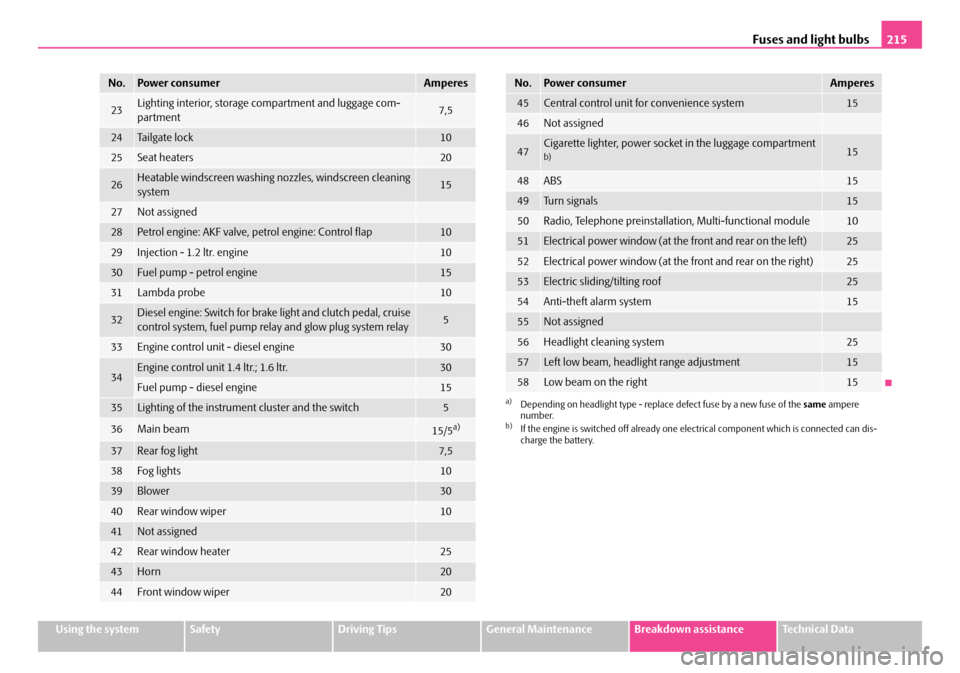
Fuses and light bulbs215
Using the systemSafetyDriving TipsGeneral MaintenanceBreakdown assistanceTechnical Data
23Lighting interior, storage compartment and luggage com-partment7,5
24Tailgate lock10
25Seat heaters20
26Heatable windscreen washing nozzles, windscreen cleaning system15
27Not assigned
28Petrol engine: AKF valve, petrol engine: Control flap10
29Injection - 1.2 ltr. engine10
30Fuel pump - petrol engine15
31Lambda probe10
32Diesel engine: Switch for brake light and clutch pedal, cruise control system, fuel pump relay and glow plug system relay5
33Engine control unit - diesel engine30
34Engine control unit 1.4 ltr.; 1.6 ltr.30
Fuel pump - diesel engine15
35Lighting of the instrument cluster and the switch5
36Main beam15/5a)
37Rear fog light7,5
38Fog lights10
39Blower30
40Rear window wiper10
41Not assigned
42Rear window heater25
43Horn20
44Front window wiper20
No.Power consumerAmperes
45Central control unit for convenience system15
46Not assigned
47Cigarette lighter, power socket in the luggage compartment b)15
48ABS15
49Turn signals15
50Radio, Telephone preinstallation, Multi-functional module10
51Electrical power window (at the front and rear on the left)25
52Electrical power window (at the front and rear on the right)25
53Electric sliding/tilting roof25
54Anti-theft alarm system15
55Not assigned
56Headlight cleaning system25
57Left low beam, headlight range adjustment15
58Low beam on the right15
a)Depending on headlight type - replace defect fuse by a new fuse of the same ampere number.b)If the engine is switched off already one electrical component which is connected can dis-charge the battery.
No.Power consumerAmperes
NKO A05F 20.book Page 215 Wednesday, April 2, 2008 1:02 PM
Page 218 of 252
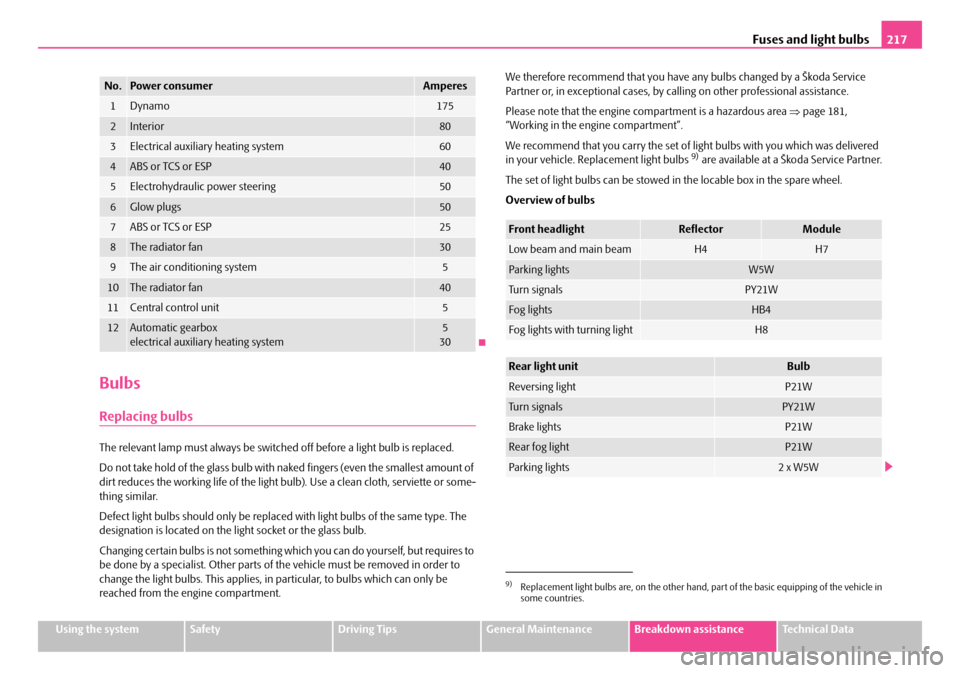
Fuses and light bulbs217
Using the systemSafetyDriving TipsGeneral MaintenanceBreakdown assistanceTechnical Data
Bulbs
Replacing bulbs
The relevant lamp must always be switched off before a light bulb is replaced.
Do not take hold of the glass bulb with naked fingers (even the smallest amount of dirt reduces the working life of the light bulb). Use a clean cloth, serviette or some-thing similar.
Defect light bulbs should only be replaced with light bulbs of the same type. The designation is located on the light socket or the glass bulb.
Changing certain bulbs is not something which you can do yourself, but requires to be done by a specialist. Other parts of the vehicle must be removed in order to change the light bulbs. This applies, in particular, to bulbs which can only be reached from the engine compartment.
We therefore recommend that you have any bulbs changed by a ┼Ākoda Service Partner or, in exceptional cases, by calling on other professional assistance.
Please note that the engine compartment is a hazardous area ŌćÆpage 181, ŌĆ£Working in the engine compartmentŌĆØ.
We recommend that you carry the set of light bulbs with you which was delivered in your vehicle. Replacement light bulbs 9) are available at a ┼Ākoda Service Partner.
The set of light bulbs can be stowed in the locable box in the spare wheel.
Overview of bulbs
No.Power consumerAmperes
1Dynamo175
2Interior80
3Electrical auxiliary heating system60
4ABS or TCS or ESP40
5Electrohydraulic power steering50
6Glow plugs50
7ABS or TCS or ESP25
8The radiator fan30
9The air conditioning system5
10The radiator fan40
11Central control unit5
12Automatic gearboxelectrical auxiliary heating system530
9)Replacement light bulbs are, on the other hand, part of the basic equipping of the vehicle insome countries.
Front headlightReflectorModule
Low beam and main beamH4H7
Parking lightsW5W
Tu r n s i g n a l sPY21W
Fog lightsHB4
Fog lights with turning lightH8
Rear light unitBulb
Reversing lightP21W
Tu r n s i g n a l sPY21W
Brake lightsP21W
Rear fog lightP21W
Parking lights2 x W5W
NKO A05F 20.book Page 217 Wednesday, April 2, 2008 1:02 PM
Page 220 of 252

Fuses and light bulbs219
Using the systemSafetyDriving TipsGeneral MaintenanceBreakdown assistanceTechnical Data
Switching on the low beam and main beam
ŌĆō Open the bonnet.
ŌĆō Remove the protective cap ŌćÆpage 218, fig. 198.
ŌĆō For headlights with module (halogen lamp H7) ŌćÆfig. 200 turn the
connector with the halogen lamp to the left up to the stop and
remove.
ŌĆō For headlights with reflector (halogen lamp H4) pull off the connector
from the lamp, release the sprung wire clamp and pull out the halogen
lamp towards the rear.
ŌĆō Replace the halogen lamp H7, insert the connector with the new
halogen lamp and turn to the right up to the stop.
ŌĆō Replace the halogen lamp H4, insert into the opening in the reflector
(with the fixing lugs in the recesses), secure with the sprung wire
clamp, position the protective cap and mount the connector.
ŌĆō We recommend that you have the headlight setting checked by a
Skoda Service Partner after replacing the light bulb.
Turn signal light (at the front)
ŌĆō Open the bonnet.
ŌĆō Turn the lamp holder to the left ŌćÆpage 218, fig. 198 and remove
the lamp holder with the light bulb.
ŌĆō Replace the defective light bulb.
ŌĆō Insert the lamp holder with light bulb into the headlight. Secure the
lamp holder by turning it to the right until it locks in place.
Parking light at the front
ŌĆō Open the bonnet.
ŌĆō Remove the protective cap ŌćÆpage 218, fig. 198.
ŌĆō Grasp the light bulb holder and pull it out of the headlight.
ŌĆō Replace the light bulb in the light bulb holder and re-insert into the
headlight.
Fog lights
Fig. 200 Removing the light bulb for the low beam and main beam light
AA
AC
AB
Fig. 201 Structure of the light bulb of the fog light
NKO A05F 20.book Page 219 Wednesday, April 2, 2008 1:02 PM